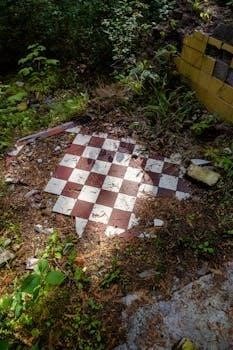The disappearing four patch is a beginner-friendly quilt block․ It involves cutting a four-patch into pieces․ This easy technique allows for a variety of designs by reassembling the cut pieces in different ways․ This method is popular for achieving unique and intricate patterns with minimal effort․
What is a Disappearing Four Patch?
The “disappearing four patch” is a quilting technique where a simple four-patch block undergoes a transformation through strategic cuts and reassembly, creating a more complex and interesting design․ This method begins with the creation of a standard four-patch block, typically composed of four squares of fabric sewn together in a two-by-two grid․ The magic happens when this block is then cut, often once vertically and once horizontally, into four equal pieces․ These four pieces are then rearranged and sewn back together, often with some rotation or flipping, to create a completely new block․ The result is a block that retains a hint of the original four-patch but boasts a more intricate and seemingly ‘disappeared’ design․ It’s called “disappearing” because the initial four-patch design appears to vanish as the new pattern takes shape․ This technique is popular because it is straightforward to learn, allowing quilters to achieve complex-looking results with minimal effort․ It is also wonderfully versatile, lending itself to various arrangements and color combinations, making it a favorite for both novice and experienced quilters․ The disappearing four patch is not just a pattern; it is a clever way to create visual interest in a quilt․
Why Choose This Pattern?
The disappearing four patch pattern is a fantastic choice for quilters of all skill levels due to its blend of simplicity and surprising visual impact․ It’s particularly appealing to beginners because the initial four-patch block construction is very straightforward․ This makes it an excellent starting point for those new to quilting, allowing them to build confidence with basic piecing before exploring more complex techniques․ Yet, even experienced quilters find the disappearing four patch appealing due to its versatility and potential for creativity․ The pattern’s magic lies in the unexpected transformations that occur with the simple cuts and rearrangements, creating intricate-looking designs without the need for advanced skills․ Moreover, this pattern is a great way to use up scrap fabrics․ The small squares required for the four-patch blocks make it perfect for utilizing leftover pieces from other projects, reducing waste and adding a touch of eclecticism to the quilt․ The endless possibilities for color and fabric combinations also allow for a high degree of personalization․ Whether aiming for a modern, scrappy look or a more traditional style, the disappearing four patch adapts beautifully to various aesthetics․ The quick construction and stunning results make it a rewarding choice for any quilting project, from small throws to large bed quilts․

Creating a Disappearing Four Patch Block
Constructing this block involves three main steps⁚ creating the initial four-patch, making a strategic cut, and then reassembling the pieces․ The process is simple yet produces complex designs․ Careful cutting is essential․
Basic Construction of the Four Patch
The foundation of the disappearing four patch technique lies in the creation of a standard four-patch block․ This initial step involves selecting four fabric squares of equal size․ These squares can be from the same fabric for a uniform look, or from different fabrics to add variety and visual interest to the final quilt․ The process begins with carefully cutting the chosen fabrics into precise squares, ensuring each one is the same dimension․ This consistency is crucial for a well-aligned block and an even quilt․ Once the squares are cut, they are arranged in a two-by-two grid․ This arrangement is the basic layout of the four-patch․ The squares are then sewn together, first in pairs and then these pairs are joined to form a complete four-patch block․
Sewing should be done with a consistent seam allowance, typically a quarter of an inch, to ensure that all seams align correctly and that the final block is square․ After sewing, the seams are pressed to one side, or open, depending on your preferred method․ Pressing is an essential step for the accuracy of the quilt․ It ensures that the block lies flat and makes subsequent steps easier․ This basic four-patch is the starting point for the disappearing magic, a foundation for the more complex designs to come․ The accuracy at this stage will directly impact the overall look of the finished quilt․
The “Disappearing” Cut
The magic of the disappearing four patch emerges with the strategic cut made to the completed four-patch block․ After constructing the basic four-patch, the next step is to make a cut, which will transform the block and create the ‘disappearing’ effect; The most common method involves cutting the four-patch block vertically and horizontally through the center․ This cut divides the block into four smaller squares of equal size․ This central cut is often referred to as the ‘disappearing’ cut because it alters the original four-patch appearance․ The placement of the cut is crucial, as it will dictate the new arrangement and the final design of the block․
For the standard disappearing four patch, the cut goes directly from edge to edge, intersecting in the center․ Some variations might use an offset cut, or a cut that goes diagonally across the block, this will result in different design effects․ The precision of this cut will impact the accuracy of the final block, so using a rotary cutter with a ruler is recommended․ Once the cut is made, the four-patch has now been transformed into separate pieces, ready for reassembling to create the new, exciting pattern․ This step is the heart of the disappearing four patch technique, introducing endless possibilities․
Reassembling the Block
After making the crucial ‘disappearing’ cut, the next step is reassembling the block, which transforms the four squares into a more intricate pattern․ This stage is where the creative magic truly happens, as the initial arrangement of the four-patch is now altered․ The newly cut pieces are rotated and rearranged, resulting in a completely different appearance from the original four-patch․ This reassembly is what gives the disappearing four patch its unique characteristic and ability to produce diverse designs․ The most common method involves rotating the four cut squares and sewing them back together․
Typically, the squares are rotated 90 degrees each before being sewn back into a block․ This simple rotation creates a new block that can look very different from the original, often incorporating elements of the initial fabric pattern․ The reassembled block is then a brand new unit with a fresh design․ The order of rotation and placement is key to the final result․ It is also crucial to maintain consistent seam allowances when sewing these pieces together, as this ensures accuracy and will help the blocks fit together nicely when forming your quilt․ Experimenting with different rotations and arrangements will lead to unique and personalized quilt blocks․

Variations and Design Ideas
Beyond the basic disappearing four patch, many creative variations can be explored․ These include using different color palettes, fabric types, and block arrangements to achieve diverse and personalized quilt designs․
Modern Disappearing Four Patch Star Quilt
The modern disappearing four patch star quilt takes the traditional block to new heights, offering a contemporary twist on a beloved pattern․ This variation often incorporates bold color choices and geometric arrangements to create a visually striking design․ The “disappearing” cut is used strategically, resulting in star-like shapes emerging from the reassembled blocks․ By carefully selecting contrasting fabrics and playing with different values, quilters can create an illusion of depth and movement․ This modern approach often emphasizes clean lines and minimalist aesthetics, making it a popular choice for those seeking a more contemporary look․ The beauty of this variation lies in its versatility; it can be adapted to various color schemes and fabric types, allowing for endless customization․ It’s a fantastic way to showcase a collection of fabrics or experiment with unique color combinations․ The interplay of light and dark fabrics can dramatically enhance the star pattern, resulting in a stunning and eye-catching finished quilt․ Furthermore, the modern star quilt frequently utilizes a grid-like layout, emphasizing the geometric nature of the design․ This method of construction is favored by many for its visual simplicity while also being relatively easy to put together․
Color and Fabric Choices
Selecting the right colors and fabrics is crucial for a successful disappearing four patch quilt․ Contrasting colors highlight the “disappearing” effect, making the design more dynamic and visually appealing․ For example, using a light fabric alongside a dark fabric for the initial four-patch can create striking contrasts when the blocks are rearranged․ Consider the overall mood you want to achieve; bright, bold colors evoke a playful feel, while muted tones can create a more sophisticated, calming atmosphere․ Fabric patterns also play a significant role․ Small-scale prints and solids work well in this pattern․ Large-scale prints may not showcase as effectively when cut into smaller pieces․ Think about mixing different types of fabrics, such as cotton, linen, or even some textured fabrics, to add dimension and visual interest․ A curated color palette ensures a harmonious finished product, so it’s wise to plan your color scheme before cutting your fabrics․ Also, ensure that your fabrics are of a similar weight to prevent any problems during the quilting process․ Finally, consider the impact of your choices on the star design itself; carefully selected colors can either enhance or diminish the visual impact of the star pattern․
Adding Borders and Sashing

Borders and sashing are essential components in completing a disappearing four patch quilt, enhancing its overall design and visual appeal․ Sashing, the fabric strips sewn between the blocks, can help define each block and create a sense of order and structure in the quilt․ A light-colored sashing can make the individual blocks pop while a darker sashing can unify the quilt; Borders, which frame the quilt, provide a resting place for the eye and can tie the entire design together․ A simple solid border is often a good choice, allowing the focus to remain on the pieced blocks․ However, borders can also be an opportunity to add more visual interest․ Think about using a pieced border to complement the blocks or using a multi-layered border for added depth․ Consider the width of your borders and sashing, as they can greatly affect the final look of the quilt; Narrow sashing can create a more modern feel, while wider sashing can evoke a traditional feel․ Also, consider the size of your quilt blocks when deciding on the width of your borders․ A border that is proportionally balanced with the size of the blocks will make the quilt look more finished and professional․ The possibilities are endless when it comes to adding borders and sashing to your disappearing four patch quilt, so don’t be afraid to experiment and see what works best for your design․

Resources and Tutorials
Numerous resources are available for the disappearing four patch․ These include online PDF patterns, video tutorials, and beginner-friendly guides․ These materials provide guidance for all skill levels․
Online PDF Patterns
The internet offers a wealth of online PDF patterns specifically designed for the disappearing four patch quilt technique․ These patterns cater to various skill levels, from beginners to more advanced quilters․ Many websites and blogs provide free downloadable PDF patterns that include step-by-step instructions, cutting guides, and layout diagrams․ These resources often feature different variations of the disappearing four patch, showcasing how diverse this seemingly simple block can be․ For those looking for more complex designs, there are also paid PDF patterns available on sites like Etsy and independent quilting websites, offering a wider range of styles and sizes․
These patterns may also include detailed material lists, suggestions for fabric choices and color palettes, and tips for achieving the best results․ Furthermore, many of these PDFs are printer-friendly, allowing you to easily access and reference the instructions while working on your project․ You can often find patterns that are specifically designed for different types of quilts, such as baby quilts, throw blankets, or larger bed quilts․ The availability of these PDF patterns makes it convenient to start a new project anytime you want, with the added benefit of having a permanent reference guide․
Video Tutorials
Numerous video tutorials are readily available online, offering visual guidance for creating a disappearing four patch quilt․ These videos are especially helpful for beginners who learn best by seeing the process demonstrated step-by-step․ Platforms like YouTube and Vimeo host countless quilting channels that feature tutorials on this technique․ These videos break down the construction of a four patch block, the crucial “disappearing” cut, and the reassembly process․
Many tutorials include close-up shots of the fabric and sewing machine, making it easier to follow along․ Some videos also cover different variations of the block and demonstrate how to create various quilt layouts․ These video tutorials often include helpful tips and tricks for precise cutting and sewing, which can improve the overall quality of your finished quilt․ Furthermore, some videos delve into fabric selection and color coordination to provide additional design inspiration․ These resources are invaluable for visual learners and offer a convenient way to learn this technique at your own pace, regardless of your location; They are also a great way to learn from different instructors, who often share their unique approaches to this popular quilt block․
Beginner-Friendly Guides
For those new to quilting, there are numerous beginner-friendly guides available that focus specifically on the disappearing four patch technique․ These guides are designed to be easy to understand, providing clear instructions and illustrations to walk you through each step․ Many of these guides are available online as blog posts or free downloadable PDFs, making them easily accessible․ These resources often include a detailed list of required materials, along with explanations of basic quilting terminology․
Furthermore, beginner guides frequently offer tips on selecting the right fabrics and colors, ensuring a visually pleasing final product․ They also typically feature clear diagrams and step-by-step photos, which make the cutting and sewing process more manageable․ These guides often emphasize the importance of accurate cutting and consistent seam allowances, which are essential for creating a well-constructed block․ Additionally, they may include troubleshooting sections to address common issues that beginners might encounter, such as fabric fraying or uneven seams․ The goal of these guides is to empower new quilters with the skills and confidence needed to create beautiful and successful disappearing four patch quilts․ Some even include variations for different quilt sizes․

